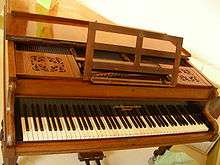John Broadwood & Sons

John Broadwood & Sons is an English piano manufacturer, founded in 1728 by Burkat Shudi and continued after his death in 1773 by John Broadwood.[1]
Early history
John Broadwood, a Scottish joiner and cabinetmaker, came to London in 1761 and began to work for the Swiss harpsichord manufacturer Burkat Shudi.[2] He married Shudi's daughter eight years later and became a partner in the firm in 1770. As the popularity of the harpsichord declined, the firm concentrated increasingly on the manufacture of pianos, abandoning the harpsichord altogether in 1793.[3]
Broadwood's son, James Shudi Broadwood, had worked for the firm since 1785, and, in 1795, the firm began to trade as John Broadwood & Son.[2] When Broadwood's third son, Thomas Broadwood, became a partner in 1808, the firm assumed the name of John Broadwood & Sons Ltd, which it retains to this day.[2] The firm's busiest time period was during the 1850s, when approximately 2,500 instruments were produced annually.[4]
Innovations

Broadwood produced his first square piano in 1771, after the model of Johannes Zumpe, and worked assiduously to develop and refine the instrument, moving the wrest plank of the earlier pianoforte, which had sat to the side of the case as in the clavichord, to the back of the case in 1781,[5] straightening the keys, and replacing the hand stops with pedals.[2] In 1785 Thomas Jefferson, later to be third President of the United States, visited Broadwood in Great Pulteney Street, Soho, to discuss musical instruments.
In 1789, at Jan Ladislav Dussek's suggestion, he extended the range of his grand piano beyond five octaves to CC in the treble, and again to six full octaves in 1794.[6] The improved instruments became popular with musicians such as Joseph Haydn, who used them on his first visit to London in 1791.[6]
Ludwig van Beethoven received a six octave Broadwood in 1818, a gift from Thomas Broadwood,[7] which he kept for the rest of his life. Although his impaired hearing may well have prevented him appreciating its tone,[8] he seems to have preferred it to his Erard which had a similar range. Above the company label on the front edge of the pin block the following text can be read: ″Hoc Instrumentum est Thomae Broadwood (Londrini) donum propter ingenium illustrissime Beethoven.″ [This instrument is a proper gift from Thomas Broadwood of London to the great Beethoven.]
Frédéric Chopin played Broadwood instruments in Britain, including at the last concert of his life given at Guildhall, London, in 1848. Although he liked Broadwoods, he appears to have preferred the French make Pleyel.[9]
1980s & 1990s
After a long period of decline ending in near bankruptcy, the business was rescued in the mid 1980s by a consortium headed up by Geoffrey Simon,[10] a keen amateur pianist and successful businessman from Birmingham. Mr Simon took on the mantle of CEO and under his stewardship John Broadwood & Sons entered a new and brighter period during which a number of innovations were developed. These included the limited edition 'Linley piano[11]' an upright piano designed by Viscount Linley and his partner Matthew Rice, plus the design and patenting of the 'barless' grand piano in 1997[12] which was manufactured by Birmingham firm of Ladbrooke Pianos, who produced half a dozen a year.
2000s
The company holds a Royal Warrant as a manufacturer and tuner of pianos.[13] Following the death of Geoffrey Simon in 2006, the company was acquired in 2008 by Dr. Alastair Laurence, a piano builder and technician with family ties to the Broadwood firm dating back to 1787. To coincide with the change in ownership, new restoration and conservation workshops are now located at Finchcocks, Goudhurst, Kent, England.
Broadwood archives
The company's archives have survived. They are held at the Surrey History Centre.[14]
References
- ↑ Latham, Alison. "Broadwood". The Oxford Companion to Music. Oxford Music Online. Retrieved 8 May 2009.
- 1 2 3 4 Adlam, Derek; Ehrlich, Cyril (2009). "Broadwood". Grove Music Online. Oxford University Press. Retrieved 5 May 2009.
- ↑ Ehrlich, Cyril (1976). "Introduction". The Piano: A History. London: J. M. Dent & Sons Ltd. p. 18. ISBN 978-0-460-04246-8.
- ↑ Bray, David (October 1994). "The Colt Clavier Collection at 50 - A Collection in Distress?". Harpsichord and Fortepiano. Ruxbury Publications, Ltd. 5 (1): 30–33.
- ↑ Dolge, Alfred (1972). "2". Pianos and their makers: a comprehensive history of the development of the piano from the monochord to the concert grand player piano. New York: Dover Publications. p. 49. ISBN 978-0-486-22856-3. Retrieved 5 May 2009.
- 1 2 Wainwright, David (October 1982). "John Broadwood, the Harpsichord and the Piano". The Musical Times. Musical Times Publications Ltd. 123 (1676): 675–678. doi:10.2307/962117. JSTOR 962117.
- ↑
- ↑ Mobbs, Kenneth; Latcham, Michael (August 1992). "Beethoven's Broadwood". Early Music. Oxford University Press. 20 (3): 527. doi:10.1093/earlyj/xx.3.527-b. JSTOR 3127739.
- ↑ Zaluski, Iwo; Zaluski, Pamela (May 1992). "Chopin in London". The Musical Times. Musical Times Publications Ltd. 133 (1791): 226–230. doi:10.2307/1193699. JSTOR 1193699.
- ↑ ""Piano Forte" by Darwent, Charles - Management Today, June 1994 | Online Research Library: Questia". www.questia.com. Retrieved 2016-03-22.
- ↑ "History of John Broadwood & Sons Ltd". www.broadwood.co.uk. Retrieved 2016-03-22.
- ↑ "A Chronological History of the Piano - Piano Time Line". www.concertpitchpiano.com. Retrieved 2016-03-22.
- ↑ "Entry for John Broadwood & Sons Ltd". The Royal Warrant Holders Association. Retrieved 31 January 2016.
- ↑ "John Broadwood". Surrey County Council. Retrieved 19 October 2014.
External links
- Broadwood & Sons Ltd.
- John Broadwood & Sons Piano Manufacturers page, Surrey County Council
- Johann Christian Bach: Sonate G-Dur, allegro
- John Broadwood & Sons Grand Piano (16000, London 1843) - The Piano in Polish Collections
